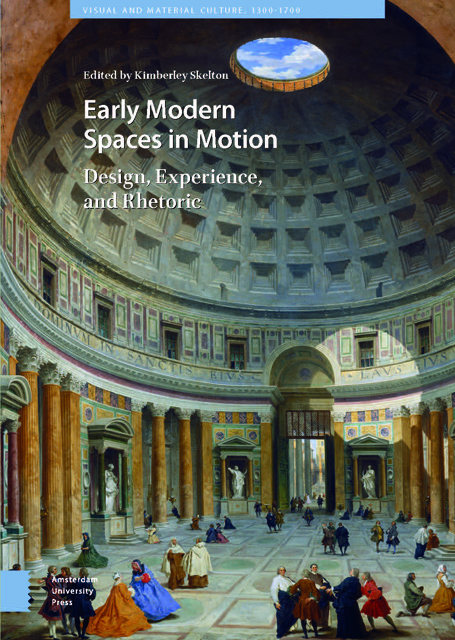Book contents
- Frontmatter
- Table of Contents
- List of Illustrations
- Acknowledgements
- Introduction: Bodies and Buildings in Motion
- 1 Navigating the Palace Underworld : Recreational Space, Pleasure, and Release at the Castello del Buonconsiglio, Trent
- 2 Passages to Fantasy : The Performance of Motion in Celliniâs Fontainebleau Portal and the Galerie François I
- 3 The Catholic Country House in Early Modern England : Motion, Pietyand Hospitality, c. 1580â1640
- 4 Sensory Vibrations and Social Reform at San Michele a Ripa in Rome
- 5 The Rise of the Staircase: Motion in Eighteenth-Century Dutch Domestic Architecture
- 6 Movement through Ruins: Re-experiencing Ancient Baalbek with Jean de la Roque
- 7 A Paper Tour of the Metropolis : The Architecture of Early Modern London in the Royal Magazine
- 8 Libraries in Motion: Forms of Movement in the Early Modern Library (1450-1770)
- Works Cited
- Index
3 - The Catholic Country House in Early Modern England : Motion, Pietyand Hospitality, c. 1580â1640
Published online by Cambridge University Press: 11 January 2023
- Frontmatter
- Table of Contents
- List of Illustrations
- Acknowledgements
- Introduction: Bodies and Buildings in Motion
- 1 Navigating the Palace Underworld : Recreational Space, Pleasure, and Release at the Castello del Buonconsiglio, Trent
- 2 Passages to Fantasy : The Performance of Motion in Celliniâs Fontainebleau Portal and the Galerie François I
- 3 The Catholic Country House in Early Modern England : Motion, Pietyand Hospitality, c. 1580â1640
- 4 Sensory Vibrations and Social Reform at San Michele a Ripa in Rome
- 5 The Rise of the Staircase: Motion in Eighteenth-Century Dutch Domestic Architecture
- 6 Movement through Ruins: Re-experiencing Ancient Baalbek with Jean de la Roque
- 7 A Paper Tour of the Metropolis : The Architecture of Early Modern London in the Royal Magazine
- 8 Libraries in Motion: Forms of Movement in the Early Modern Library (1450-1770)
- Works Cited
- Index
Summary
Abstract
The survival of a Roman Catholic minority in post-Reformation England did not depend merely upon social separation and isolation. By analysing missionary activities and patterns of hospitality at St Anthony’s Hall in Northumberland and Naworth Castle in Cumberland, I demonstrate how regulation of human motion in respective households shaped and displayed the social behaviour of their owners. I argue that religion was as much a driving force behind the seclusion of the Catholic home as an incentive for its accessibility. The permeability of Catholic houses and social integration of Catholics was encouraged through missionary mobility, indiscriminate charity, and Christmas hospitality. Examining human motion in Catholic houses further challenges the notion of the English Catholic community as an introverted social group.
Keywords: St Anthony’s Hall, Naworth Castle, Catholic mission, Christmas hospitality, festive mobility
After the English Reformation, which violently expelled the old faith from its traditional places of worship and confined it primarily to the household, Catholic houses – in particular, those of the landed elites – not only became the principal places of Roman Catholic devotion, but also politically charged spaces, which the government perceived as seedbeds of ‘popery’ and sedition. State surveillance and violent raids of private homes by pursuivants, the official agents of the Privy Council, drastically increased after the first Jesuit mission in 1580 and subsequent introduction of a more rigorous recusant legislation. After 1585, for example, harbouring or assisting a priest became a felony punishable by death. It is therefore hardly surprising that continuous public scrutiny forced Catholics to take precaution and conduct their private devotional life as covertly as possible. Purpose-built hides, secret garrets, chapels, and passages as well as convenient geography and landscaping, permitting quick and stealthy movements of priests to and from the property, uniquely altered the plans and experience of Catholic homes and became essential to the fully functioning recusant household.
However, the new features were not planned to merely conceal objects, practices, and individuals, but also to regulate and even encourage their circulation, which was crucial for sustaining Catholic religious life. By designing secluded lanes and secret hides, Catholics hoped to simultaneously frustrate pursuivants’ violent intrusions as well as to facilitate secretive motions of priests, fellow coreligionists, illegal books, and devotional objects.
- Type
- Chapter
- Information
- Early Modern Spaces in MotionDesign, Experience and Rhetoric, pp. 81 - 110Publisher: Amsterdam University PressPrint publication year: 2020



